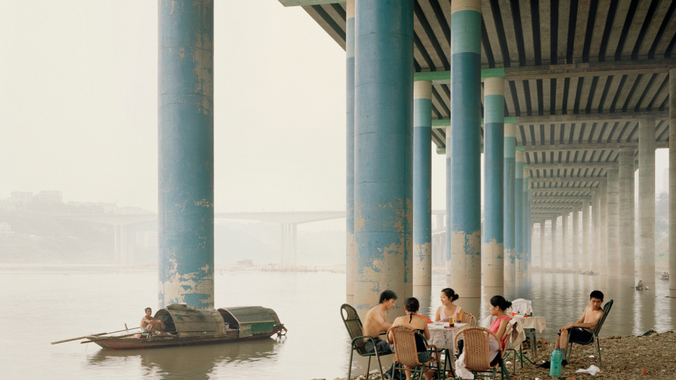South African photographers Nadav Kander and Guy Tillim interrogate the built environment to uncover its sensibilities alongside the sublime, reports Jeremy Kuper.
Constructing Worlds, a new exhibition at London’s Barbican Centre, explores the relationship between photography and the built environment. It features work from leading photographers around the world, including two South Africans, Nadav Kander and Guy Tillim.
Nadav Kander
For his series Yangtze: The Long River, Nadav Kander travelled to China five times to take photographs along the 4100-mile long Yangtze River. “The river is a metaphor for constant change and I used it as a corridor to keep me on track,” Kander explains.
“I work really intuitively, so it’s not like I have a strong concept and make those photographs accordingly,” he tells me. It is when he gets back from a project that he begins to analyse and question his motives. “I’m only more certain after the event,” he says, about whether he has captured what he was after.
“I think that learning by looking, learning by seeing what works for you, you start to discover your motives, how you tick, and what you are responding to. And it becomes a thread that runs through each project.”
Small human figures are framed alongside enormous structures. The overbearing straight lines of China’s growing industrial landscape are set against the formless river under a hazy coloured sky.
“I think all of my work is about mankind. And my landscape work is about our proximity to nature. I’ve never been a landscape photographer trying to photograph just nature, it is always about how we live and how we show our palm print on nature. Nothing is more interesting to me than man-made structures.”
Kander’s use of scale draws on the idea of the sublime in art. Of man within a vast hostile world, still managing to cling on to that rock in the Yangtze. But here man is set both in nature and the modern world of factories and progress.
In Kander’s alien landscape tiny figures are gathered on a rock beside the river taking turns to dive in. In another, people sit in chairs wearing only their underwear, because of the heat, playing cards beneath a bridge. A man on an old-fashioned Chinese boat looks on.
“I think that these are people who are finding their way. I find quite a lot of compassion for people finding their way through such change that’s going on around them, that they have no knowledge about or control over,” he comments.
“They are having a wonderful Sunday picnic … playing cards. The other guys are swimming in the river, they’re getting pushed down the river and then coming out a mile down. Then running back to that rock and jumping into the fast flowing river again. And if you look closely, you can see the chimneys of the factories through the haze in the background.”
Guy Tillim
For his Avenue Patrice Lumumba project, Guy Tillim set off on a journey across sub-Saharan Africa to document urban environments built in the 1960s and 70s. This period coincided with rapid decolonisation in countries like Mozambique and Angola. Tillim’s work focuses in on some of the dilapidated concrete structures left behind.
“I’m accused of being a connoisseur of decay,” says Tillim. “That’s not a very pleasant expression really, because the texture of decay is so alluring, that it’s pretty easy to create an image that has this texture that draws you in and it’s full of pathos and so on. But one wants to try and steer away from that to some extent.”
These buildings “represented a colonial dream, but they were also adopted by post-colonial governments and people in Africa. They represent also a decay of this dream.”
“It’s difficult to describe what that dream was, just prosperity? Was it a dream of imitating colonial administrators in power? Was it a dream of African identity and if so, what is that? There are many more questions than answers.” says Tillim.
“The decay is not easy to read,” he contests. “It’s a breakdown in society to some extent, but the point of the breakdown is that it’s not identified just by looking at the wall and saying this is the African way.”
Tillim admits that he found a certain beauty in the concrete structures, with their crumbling paintwork, mould and neglect. “I think the photographs, to my mind, have to be beautiful. One has to look for beauty. It’s just that what beauty are you looking for, is it a cliché of the notion of beauty?” he asks.
“Does it create a window onto a world? If it does, that’s beautiful. And a window onto a world is looked into, not looked at. I think that’s the crucial difference and I think that’s the difficulty with these kind of photographs, is that you tend to look at them.”
Tillim describes the unreality of some of these places, constructed in a short space of time and then abandoned in haste. He tells me it feels surreal for the buildings to be there and that somehow these structures have now ‘become assimilated’.
via Mail & Guardian
[See: Brett Bailey, another South African at the Barbican]






